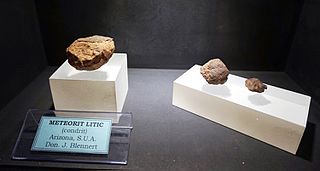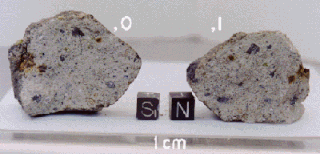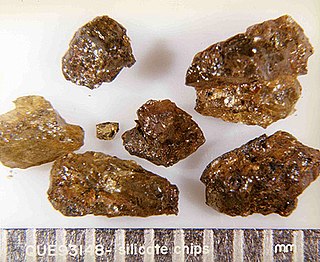
In meteoritics, a meteorite classification system attempts to group similar meteorites and allows scientists to communicate with a standardized terminology when discussing them. Meteorites are classified according to a variety of characteristics, especially mineralogical, petrological, chemical, and isotopic properties.

In planetary science, planetary differentiation is the process by which the chemical elements of a planetary body accumulate in different areas of that body, due to their physical or chemical behavior. The process of planetary differentiation is mediated by partial melting with heat from radioactive isotope decay and planetary accretion. Planetary differentiation has occurred on planets, dwarf planets, the asteroid 4 Vesta, and natural satellites.

An achondrite is a stony meteorite that does not contain chondrules. It consists of material similar to terrestrial basalts or plutonic rocks and has been differentiated and reprocessed to a lesser or greater degree due to melting and recrystallization on or within meteorite parent bodies. As a result, achondrites have distinct textures and mineralogies indicative of igneous processes.

HED meteorites are a clan (subgroup) of achondrite meteorites. HED stands for "howardite–eucrite–diogenite". These achondrites came from a differentiated parent body and experienced extensive igneous processing not much different from the magmatic rocks found on Earth and for this reason they closely resemble terrestrial igneous rocks.

Iron meteorites, also called siderites or ferrous meteorites, are a type of meteorite that consist overwhelmingly of an iron–nickel alloy known as meteoric iron that usually consists of two mineral phases: kamacite and taenite. Most iron meteorites originate from cores of planetesimals, with the exception of the IIE iron meteorite group
In geology, igneous differentiation, or magmatic differentiation, is an umbrella term for the various processes by which magmas undergo bulk chemical change during the partial melting process, cooling, emplacement, or eruption. The sequence of magmas produced by igneous differentiation is known as a magma series.

Fractional crystallization, or crystal fractionation, is one of the most important geochemical and physical processes operating within crust and mantle of a rocky planetary body, such as the Earth. It is important in the formation of igneous rocks because it is one of the main processes of magmatic differentiation. Fractional crystallization is also important in the formation of sedimentary evaporite rocks or simply fractional crystallization is the removal of early formed crystals from an Original homogeneous magma so that the crystals are prevented from further reaction with the residual melt.
Magmatic water, also known as juvenile water, is an aqueous phase in equilibrium with minerals that have been dissolved by magma deep within the Earth's crust and is released to the atmosphere during a volcanic eruption. It plays a key role in assessing the crystallization of igneous rocks, particularly silicates, as well as the rheology and evolution of magma chambers. Magma is composed of minerals, crystals and volatiles in varying relative natural abundance. Magmatic differentiation varies significantly based on various factors, most notably the presence of water. An abundance of volatiles within magma chambers decreases viscosity and leads to the formation of minerals bearing halogens, including chloride and hydroxide groups. In addition, the relative abundance of volatiles varies within basaltic, andesitic, and rhyolitic magma chambers, leading to some volcanoes being exceedingly more explosive than others. Magmatic water is practically insoluble in silicate melts but has demonstrated the highest solubility within rhyolitic melts. An abundance of magmatic water has been shown to lead to high-grade deformation, altering the amount of δ18O and δ2H within host rocks.

Igneous rock, or magmatic rock, is one of the three main rock types, the others being sedimentary and metamorphic. Igneous rocks are formed through the cooling and solidification of magma or lava.

Primitive achondrites are a subdivision of meteorites. They are classified on the same rank and lying between chondrites and achondrites. They are called primitive because they are achondrites that have retained much of their original chondritic properties. Very characteristic are relic chondrules and chemical compositions close to the composition of chondrites. These observations are explained as melt residues, partial melting, or extensive recrystallization.

Lodranites are a small group of primitive achondrite meteorites that consists of meteoric iron and silicate minerals. Olivine and pyroxene make up most of the silicate minerals. Like all primitive achondrites lodranites share similarities with chondrites and achondrites.
Winonaites are a group of primitive achondrite meteorites. Like all primitive achondrites, winonaites share similarities with chondrites and achondrites. They show signs of metamorphism, partial melting, brecciation and relic chondrules. Their chemical and mineralogical composition lies between H and E chondrites.

IAB meteorites are a group of iron meteorites according to their overall composition and a group of primitive achondrites because of silicate inclusions that show a strong affinity to winonaites and chondrites.

IIICD meteorites are a group of primitive achondrites. They are classified in a clan together with the IAB meteorites and the winonaites.

IVB meteorites are a group of ataxite iron meteorites classified as achondrites. The IVB group has the most extreme chemical compositions of all iron meteorites, meaning that examples of the group are depleted in volatile elements and enriched in refractory elements compared to other iron meteorites.
IIG meteorites are a group of iron meteorites. The group currently has six members. They are hexahedrites with large amounts of schreibersite. The meteoric iron is composed of kamacite.

Stony-iron meteorites or siderolites are meteorites that consist of nearly equal parts of meteoric iron and silicates. This distinguishes them from the stony meteorites, that are mostly silicates, and the iron meteorites, that are mostly meteoric iron.
This is a glossary of terms used in meteoritics, the science of meteorites.

IIAB meteorites are a group of iron meteorites. Their structural classification ranges from hexahedrites to octahedrites. IIABs have the lowest concentration of nickel of all iron meteorite groups. Most iron meteorites are derived from the metallic planetary cores of their respective parent bodies, but in the case of the IIABs the metallic magma separated to form not only this meteorite group but also the IIG group.
Bunburra Rockhole is an anomalous basaltic achondritic meteorite. Originally classified as a eucrite, it was thought to belong to a group of meteorites that originated from the asteroid 4 Vesta, but has since been reclassified based on oxygen and chromium isotopic compositions. It was observed to fall on July 21, 2007, 04:43:56 local time, by the Desert Fireball Network (DFN). Two fragments weighing 150g and 174g were recovered by the DFN at 31°21.0′S, 129°11.4′E in the Nullarbor Desert region, South Australia in November of the same year. This is the first meteorite to be recovered using the Desert Fireball Network observatory.














